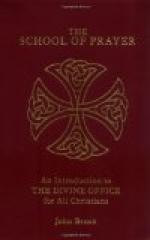The following lines, giving the rules for terminations, are well known and are useful, as a help to the memory:—
Per Dominum dicas, si Patrem quilibet oras Si Christum memores, Per eundem, dicere debes Si loqueris Christo, Qui vivis scire memento; Qui tecum, si sit collectae finisin ipso Si Flamen memores ejusdem die prope finem
When there are several collects an ending or conclusion is added to the first and last only. Dominus vobiscum is said before the first collect only, but each collect is preceded by the word Oremus, unless in the Office for the Dead.
Explanation of the Rubric. Where a feast is transferred either occasionally or always and its collect contains words such as Hanc diem, hodiernom diem, it is not allowed to change the wording, without permission of the Congregation of Rites (S.R.C., 7th September, 1916).
If the collect of a commemoration be of the same form as the prayer of the feast, the former is taken from the common of saints, in proper place.
Dominus vobiscum. This salutation is of great antiquity. It was the greeting of Booz to his harvestmen (Ruth, ii. 4). The prophet used the selfsame salutation to Azas. And the Angel Gabriel expressed the same idea, Dominns tecum, to the Blessed Virgin. It was blessed and honoured by our Lord Himself, when to His apostles he said “Ecce ego vobiscum sum omnibus diebus” (St. Matt. 28. 20). This beautiful salutation passed into Church liturgy at an early date, probably in apostolic times. Its use in liturgy was mentioned at the Council of Braga (563), and it is found in the Sacramentarium Gelasianum (sixth century). These words are called




